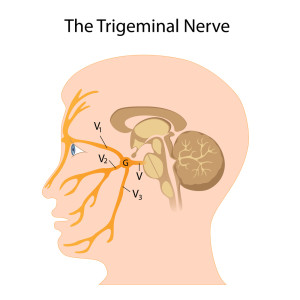Introduction
Trigeminal neuralgia is a chronic pain syndrome in the facial area affecting the trigeminal nerve, which supplies the nerve fibers of teeth, the jaws, the sinus cavities and the skin around eyes and the forehead.
The pathological lesion is sitting at the exit of the nerve fibers of the trigeminus nerve from the brain stem area, called “pons”.
With sudden head motions such as from head concussions, automobile accidents or head injuries sustained in fights micro breaks of the sheathing material where the nerve exits, occurs. From there onward a degenerative demyelinating process similar to multiple sclerosis happens at this spot resulting in a short circuit of electrical stimuli. Other than trauma there can be medical illnesses such as shingles (= herpes zoster, left ophthalmic branch) or multiple sclerosis that can give rise to trigeminal neuralgia.
Temporomandibular joint dysfunction, temporal arteritis, dental disease, cluster headaches or sinus infections have to be ruled out. Rarely there can be a tumor in the brain stem area that can cause trigeminal neuralgia (Ref. 5, p. 993).
Signs and symptoms
The clinical correlate to this pathological process are shooting pains that are some of the most piercing, excruciating pains.
The trigeminal nerves a very powerful nerve amplifying a tooth ache or sinusitis pain several times under normal anatomical conditions. However, with trigeminal neuralgia there are unpredictable spasms of a piercing, electrical sensation on one side of the face involving either the gums, jaw, lips or area around and below the eye. A minor touch to the skin in this area can trigger a sudden spasm of this pain, which lasts several minutes. But there can also be a more chronic underlying pain that is there all the time, day and night.
Diagnostic tests
An MRI scan is often desirable to rule out any anatomic abnormality such as a tumor or one of the conditions mentioned above.
Treatment with medication
The treatment of choice is Carbamazepine (Tegretol), which is the main medication for trigeminal neuralgia. If this alone does not help to control the pain, Baclofen (brand names: Lioresal Oral, Liotec) can be added.
This medication stimulates the release of the gamma-aminobutyric acid (GABA) and this counteracts the electrical stimuli from the pain fibers. Baclofen and carbamazepine can be taken simultaneously and is more effective than if each is taken alone. Side-effects of carbamazepine are tolerance after about 3 years, skin rash, liver and bone marrow toxicity, so that about 15% have to stop this medication. Baclofen side-effects can be drowsiness, weakness, dizziness, fatigue and others. Ask your physician for guidance. Another medication that releases GABA in some parts of the brain and inhibits the NMDA pain receptors is gabapentin (brand name: Neurontin). Dr. Stephen Clarke, Clinical Assistant Professor in the Div. of Neurology of the University of BC/Vancouver/Canada, reviewed the use of gabapentin for trigeminal neuralgia at a conference in Vancouver/BC in November 2004 (Ref. 10).
Surgical treatment
Those cases that do not respond to medication or where medication is not tolerated, can be permanently treated with neurosurgical procedures. One such procedure is called microvascular decompression. Here is a link to a site showing such a surgical approach (thanks to umanitoba.ca for this link).
References:
1. Goldman: Cecil Textbook of Medicine, 21st ed.,2000, W. B. Saunders Company
2. B. Sears: “The top 100 zone foods”. Regan Books, Harper Collins, 2001.
3. The Merck Manual, 7th edition, by M. H. Beers et al., Whitehouse Station, N.J., 1999. Chapter 176.
4. Noble: Textbook of Primary Care Medicine, 3rd ed.,2001, Mosby, Inc.
5. Goroll: Primary Care Medicine, 4th ed.,2000, Lippincott Williams & Wilkins
6.Rosen: Emergency Medicine: Concepts and Clinical Practice, 4th ed., 1998, Mosby-Year Book, Inc.
7. Ruddy: Kelley’s Textbook of Rheumatology, 6th ed.,2001, W. B. Saunders Company
8. Ferri: Ferri’s Clinical Advisor: Instant Diagnosis and Treatment, 2004 ed., Copyright © 2004 Mosby, Inc.
9. Rakel: Conn’s Current Therapy 2004, 56th ed., Copyright © 2004 Elsevier
10. The 50th Annual St. Paul’s Hospital Continuing Medical Education Conference for Primary Physicians, Nov. 16 – 19, 2004
11. Suzanne Somers: “Breakthrough” Eight Steps to Wellness– Life-altering Secrets from Today’s Cutting-edge Doctors”, Crown Publishers, 2008







